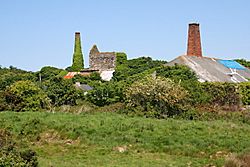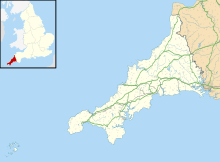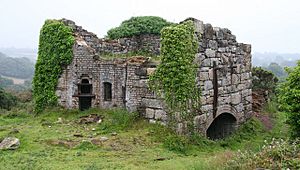Wheal Busy facts for kids

Old mine buildings at Wheal Busy
|
|
| Location | |
|---|---|
| Location | Chacewater |
| County | Cornwall |
| Country | England |
| Coordinates | 50°15′29″N 5°10′26″W / 50.258°N 5.174°W |
| Production | |
| Products | Mainly copper, tin and arsenic |
| History | |
| Opened | 16th century |
| Closed | 1920s |
Wheal Busy was a very important mine in Cornwall, England. It was located between the towns of Redruth and Truro. In its early days, it was known as Chacewater Mine. Later, it was sometimes called Great Wheal Busy.
During the 1700s, Wheal Busy was incredibly rich. It dug up huge amounts of copper ore. However, by the late 1800s, it stopped making money. Today, the mine site is part of a special place called the Cornwall and West Devon Mining Landscape World Heritage Site. This means it's recognized globally for its history.
Contents
What Was Mined at Wheal Busy?
The main rock found at the mine was called killas. Wheal Busy mostly produced copper. But it also dug up arsenic and tin. The valuable metals were found in long veins, or "lodes," within the rock. Some of these veins were cut across by a thick rock wall called an elvan dyke. This dyke was about 4.5 to 12 meters (15 to 40 feet) wide. In some spots, it also contained many minerals.
Early Days of the Mine
People probably started mining in the Wheal Busy area way back in the 1500s. But it wasn't until the 1720s that the mine really started to produce a lot of copper. The land where the mine was located belonged to the Boscawen family.
Wheal Busy was in an area once called "the richest square mile on Earth." Over its lifetime, the mine produced more than 100,000 tons of copper ore. It also dug up 27,000 tons of arsenic. The mine officially got the name Wheal Busy after 1823. For a while, the mine even processed its own copper ore.
How Steam Engines Helped
Water was a big problem for the mine. It kept flooding the underground tunnels. To pump out this water, one of the very first Newcomen engines in Cornwall was installed in 1727. This engine was built by Joseph Hornblower.
In 1775, a new, larger engine was put in. It was designed by John Smeaton. But it didn't work very well. So, in 1778, James Watt rebuilt it. This made it one of the first Watt steam engines in the county. Also in 1778, the mine got connected to the Great County Adit. This was a huge tunnel system that helped drain water from many mines.
Challenges in the Later Years
In 1856, the mine was restarted. To celebrate, a huge party was held in the village of Chacewater. A thousand people marched to the mine. They watched as the first stone for a new engine house was laid. There was a special train trip, a church service, and dinner for 400 people. At night, fireworks lit up the sky. A whole ox was roasted for the feast!
Even with all this excitement, the mine struggled. Over the next ten years, it produced a lot of copper and tin. But it never made a profit. The owners lost a lot of money.
In 1866, some miners caused trouble. The mine captain tried to cut their pay to save money. This made the miners very angry. Newspaper reports said they tried to blow up boilers and set fires. They also threw large pieces of iron into the pumps. The mine closed down soon after this.
The water from the mine was very harsh. It damaged the steam engines' boilers. Six out of twenty-four boilers had to be replaced every year! It wasn't until 1862 that the mine got a supply of clean water. The last big amount of copper ore was dug up in 1866.
In 1873, the mine reopened during a time when copper prices were low. A new, very large pumping engine was bought. But only seven months later, the engine was for sale. The mine closed again without digging up any ore.
Around 1910, another large pumping engine was installed. A special machine called a Brunton calciner was built to help produce arsenic. In the 1920s, machines called Californian stamps were used. They would crush the old waste piles to find more ore. During the Second World War, American soldiers stayed at the site. They were said to have restarted the pumping engine.
Wheal Busy Today
Today, the Wheal Busy site is part of the Cornwall and West Devon Mining Landscape World Heritage Site. You can still see the remains of the Brunton calciner. The concrete bases of the Californian stamps are also visible. A bike path, called the Mineral Tramways cycle path, goes right past the mine.
The mine has been a protected historical site since 1974. Many of its buildings are also listed as important historical structures. These include the engine house, arsenic calciner, chapel, and smithy building. In 2011, many of the mine's buildings needed repairs. Funding was found to fix the engine house and other buildings. This work was finished in 2015. The smithy building still needs repairs, and people hope to find money to fix it too.



